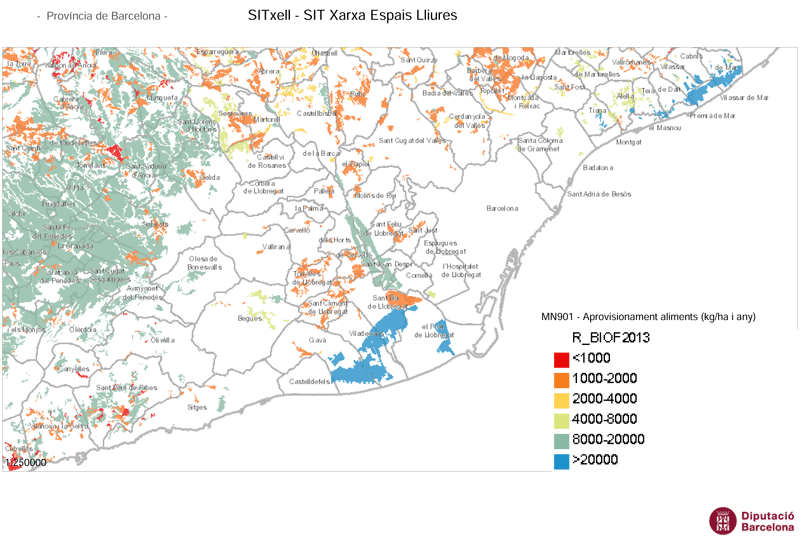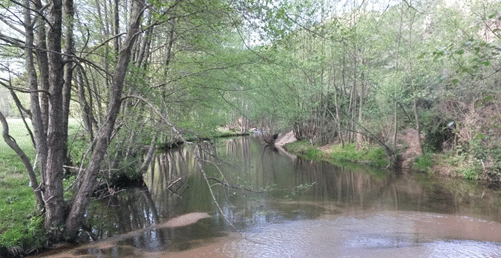Case Study
SITXELL – Incorporation of the ecological values of natural spaces to urban and land planning.
Contact name
Carles Castell
Institution name
Diputació de Barcelona (Barcelona Provincial Council)
Region & country
Catalonia, Spain
Summary
SITXELL was conceived as a tool to tackle the absence of a common territorial planning basis for the Barcelona region, the insufficient administrative coordination between departments and administrations, and the heterogeneity of the existing information.
The Territorial Information System for the Network of Open Areas (SITXELL), incorporates information on the values of natural spaces based on scientific data to help identifying, analyzing, evaluating and planning open spaces. Its ultimate goal is to highlight the natural and socio-economic values of undeveloped land, including the ecosystem services, and use them to maximize its potential and reduce negative impacts.
Currently SITXELL is a fully developed multidisciplinary tool that has improved the efficiency of the administrations of Barcelona region in planning and managing open spaces reducing its associated costs.

Ecosystem Services map generated through SITXELL
by Barcelona Provincial Council

Example of Ecosystem Services - River banks protection.
by Barcelona Provincial Council
Background of the project
In Spain, the municipal councils are responsible for town planning, while the regional governments, and within them different departments, have powers over territorial planning. Despite the existing coordination mechanisms, there is a need for an agreed overall territorial plan, which leads to problems associated with conflicts over land uses, duplication of actions, and the consequent additional costs.
Meanwhile, in academic circles and the public administration, the idea of considering the whole territory as one ecological system was starting to be approached.
The main necessities detected were:
- deficient inter-administrative coordination;
- the need for a new conceptual framework in territorial planning;
- the need for new, reliable territorial information at an affordable cost;
- dissemination of such information and training for planning officers in using it.
Solution and actions taken
The Barcelona Provincial Council developed SITXELL, a multidisciplinary territorial analysis tool, to assess decision-making processes about open spaces. Its ultimate objective is maximizing the socio-economic development compatible with the preservation of ecosystem services, which are essential for the maintenance of human welfare.
SITXELL is a GIS based cartographic and alphanumeric database at reference scale of 1: 50,000 that gathers the most advanced knowledge on territorial analysis (geology, socio-economics, town planning, territorial organisation…) from independent groups of experts and the administration itself.
In recent years, the ecosystem services approach has been integrated in this system.
The creation of SITXELL started with:
- 2001-2002: Identification of initial problems on territory planning and strategies to tackle them.
- 2003: Development of a pilot project and its extension to trusted public and private institutions.
- 2004-2006: Extension of the project to the whole province, in terms of cartographical information coverage, processes integration and structure.
- 2007: First use in territorial planning and public release.
- 2009: Full project implementation and publication online (www.sitxell.eu).
- 2014: Inclusion of ecosystem services in the system (identification and mapping).
Other institutions or parties involved
For the creation of SITXELL, collaboration was established with various organisms in order to guarantee the quality of the information and the maximum objectivity of the ratings:
- Various Areas of the Barcelona Provincial Council (Informatics, Cartography …);
- University Departments (UB, UAB);
- Research Centers (CREAF, ICTA, CTFC);
- Specialized companies;
- NGOs;
- Farmers Trade Union;
- Generalitat de Catalunya (Catalonia Regional Government).
Results
The information is offered online via the Barcelona Provincial Council map server free of charge for its use by the agents involved in territorial planning.
Since its release in 2009, SITXELL has received around 60,000 visits a year, it is regularly used by city councils for municipal planning and protected areas planning, and has allowed municipal councils to achieve savings of around 150,000 euros per year in the creation of specific maps for drawing up territorial analyses.
Nowadays, cartography of natural values and ecosystem services is broadly used in urban and land planning. Since 2015, several municipalities have incorporated local green infrastructure to their urban plan.
Furthermore, the project has served to develop a solid alliance with collaborating scientific teams and many other institutions, improved the existing procedures between the different departments of Barcelona Provincial Council involved in territory planning avoiding duplication.
Challenges
- Lack of a solid conceptual planning basis for the whole territory.
- Dispersal of planning actors and of the territorial information, which was present in a variety of formats and obtained using different methodologies.
- The lack of networking culture, which hampered the incorporation of all research teams, businesses, social institutions and administrations into the project.
- Convincing the planning actors of the quality and usefulness of the information supplied and the potential of the analyses carried out.
- Transferring the knowledge techniques to the officers in charge of territorial planning.
- The time period for achieving results is quite long.
- Limited financial resources.
Lessons learned
- The teamwork based on shared information and knowledge has promoted personal commitment and the feeling of belonging to the group.
- The integrated transversal view of the model, its flexibility and the multidisciplinary view of the territory are key aspects in the acceptance and support of the various administrations and social organisations involved.
- Without clear political commitment to the project, firstly from the leaders of Barcelona Provincial Council and then in the other administrations involved, it would have been impossible to achieve the current success.
Contact name
Carles Castell
Institution name
Diputació de Barcelona (Barcelona Provincial Council)
Website(s)
